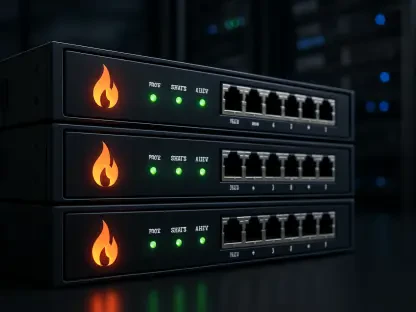What happens when two tech giants combine their expertise to tackle the escalating demands of modern enterprise networks? In an era where data-intensive applications and AI workloads push infrastructure to its limits, Broadcom and Cisco have forged a partnership that promises to redefine private cloud environments. This collaboration is not just a technical upgrade—it’s a bold step toward simplifying complexity and empowering businesses with scalable, secure solutions.
Why Private Cloud Innovation Is Critical Today
The urgency for modernized private cloud solutions has reached a tipping point. With enterprises facing a staggering 40% annual growth in data volume, as reported by industry analysts, legacy systems often buckle under the pressure of hybrid setups and AI-driven demands. This challenge creates a pressing need for networking that can scale effortlessly while maintaining robust security and control.
Beyond raw numbers, the stakes involve operational efficiency. Companies struggle with fragmented systems that lack interoperability, leading to costly delays and stifled innovation. Broadcom, in tandem with Cisco, is addressing these hurdles by introducing a framework that aligns with the industry’s shift toward open standards and streamlined management, ensuring that private cloud infrastructure keeps pace with relentless technological evolution.
Core Elements of a Game-Changing Collaboration
At the heart of this transformative effort lies Broadcom’s VMware Cloud Foundation (VCF), enhanced through a standards-based networking fabric. Utilizing Ethernet VPN (EVPN) and Border Gateway Protocol (BGP), this approach creates a seamless network layer that simplifies management. EVPN bridges connectivity across complex layers, while BGP bolsters redundancy and traffic optimization, crafting a resilient backbone for enterprise needs.
The integration with Cisco’s Nexus platform, particularly the Nexus One fabric, adds another layer of sophistication. By leveraging VXLAN EVPN for robust control and data planes, this synergy ensures consistent routing and visibility, alongside virtual private cloud protection. Cisco’s Nexus Dashboard further streamlines operations by offering a centralized interface to manage diverse fabrics, from AI to storage area networks, reducing administrative overhead in multifaceted environments.
Additionally, Broadcom extends its reach with edge-optimized nodes—rugged servers tailored for harsh, remote settings like industrial zones. Coupled with an expanded hardware certification program, this initiative supports cutting-edge technologies such as next-gen GPUs and accelerators, enabling businesses to adapt their private cloud setups to specialized and future-ready use cases with ease.
Expert Perspectives on the Impact
Industry leaders have taken note of this groundbreaking integration. Prashanth Shenoy, CMO and VP of Marketing for Broadcom’s VCF Division, highlights the strategic vision: “This unified fabric delivers the simplicity of public cloud within private environments, ensuring interoperability across diverse systems.” Such insights underscore a deliberate focus on reducing operational friction for enterprise clients.
Validation extends beyond internal voices, with external experts echoing the sentiment. Analysts point out that tools like Cisco’s Nexus Dashboard are pivotal for navigating the intricacies of AI workloads, which demand exceptional performance and security. Early feedback from enterprise adopters reveals tangible benefits, including deployment times slashed by up to 30%, illustrating the real-world value of enhanced network visibility and control.
Real-World Transformations and Success Stories
Consider the case of a multinational logistics firm that recently adopted this integrated solution. Struggling with disjointed networking across global data centers, the company faced frequent downtime and sluggish responses to market demands. By implementing Broadcom’s VCF with Cisco Nexus integration, it achieved a unified fabric that cut latency by 25% and improved system uptime, directly boosting operational agility.
Another example emerges from the retail sector, where a chain with numerous edge locations leveraged Broadcom’s rugged nodes for remote sites. Previously hampered by inconsistent performance in harsh environments, the retailer now enjoys seamless private cloud connectivity at far-flung outlets, ensuring real-time inventory updates and enhanced customer experiences. These stories highlight how tailored solutions can address unique industry pain points effectively.
Practical Steps for Enterprises to Adopt This Innovation
Enterprises eager to harness these advancements can follow a structured path to integration. Begin by auditing existing network infrastructure for alignment with EVPN and BGP standards, laying the groundwork for a unified fabric that enhances scalability. This foundational step ensures readiness for the dynamic demands of modern workloads.
For those already utilizing Cisco technologies, adopting the Nexus One fabric and Dashboard offers centralized oversight across VCF and third-party tools, simplifying management. Additionally, exploring edge-optimized nodes can extend private cloud capabilities to remote or challenging locations, while engaging in Broadcom’s hardware certification program prepares infrastructure for next-gen innovations like AI accelerators. These actionable measures provide a clear roadmap to transform private cloud operations, aligning with evolving business needs for resilience and adaptability.
Reflecting on a Milestone in Cloud Networking
Looking back, the partnership between Broadcom and Cisco marked a pivotal moment in addressing the complexities of private cloud environments. Their combined efforts tackled critical challenges, from scalability to interoperability, setting a new benchmark for enterprise infrastructure. The introduction of unified fabrics and edge solutions reshaped how businesses approached data-intensive demands.
As a next step, enterprises were encouraged to evaluate their readiness for such integrations, focusing on aligning with open standards to future-proof their networks. Industry stakeholders also anticipated further innovations in this space, particularly around AI optimization, signaling that the journey toward simplified, robust private cloud solutions had only just begun.









